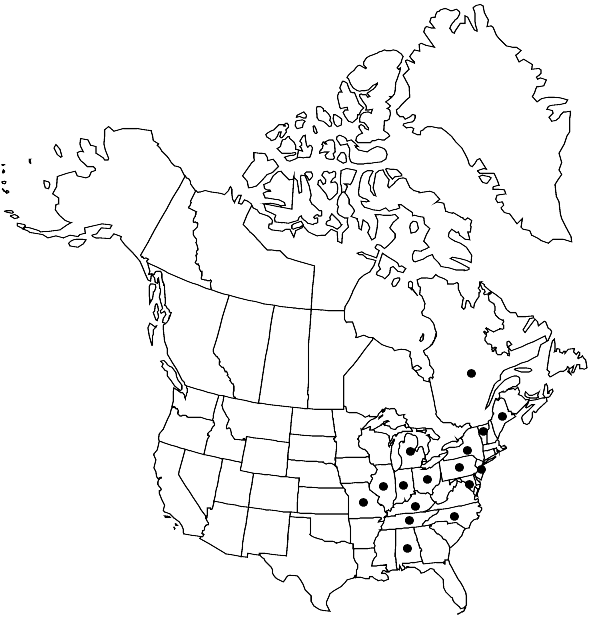Difference between revisions of "Fissidens exilis"
Sp. Musc. Frond., 152, plate 38, figs. 7–19. 1801,.
FNA>Volume Importer |
imported>Volume Importer |
||
| (6 intermediate revisions by 2 users not shown) | |||
| Line 20: | Line 20: | ||
|habitat=Bare, damp soil of shaded banks and in seepage areas | |habitat=Bare, damp soil of shaded banks and in seepage areas | ||
|distribution=Que.;Ala.;Ill.;Ind.;Ky.;Maine;Md.;Mich.;Mo.;N.J.;N.Y.;N.C.;Ohio;Pa.;Tenn.;Vt.;Europe;Asia;Africa;also introduced in West Indies. | |distribution=Que.;Ala.;Ill.;Ind.;Ky.;Maine;Md.;Mich.;Mo.;N.J.;N.Y.;N.C.;Ohio;Pa.;Tenn.;Vt.;Europe;Asia;Africa;also introduced in West Indies. | ||
| − | |discussion=<p>Fissidens exilis, first reported for North America by W. C. Steere (1950), is probably inadvertently introduced from Europe. It can be distinguished from all other tiny Fissidens in the flora area by the 2–3 rows of irregularly elongate intralaminal cells in the vaginant laminae. Plants of this species would be easily passed over were it not for the persistent protonemata that often form dark green velvetlike carpets over the substrate and the numerous sporophytes that are produced. The gemmiform perigonia are often seen scattered over the protonemata. B. H. Allen et al. (2004) have reviewed and mapped the distribution of F. exilis in North America.</p> | + | |introduced=true |
| + | |discussion=<p><i>Fissidens exilis</i>, first reported for North America by W. C. Steere (1950), is probably inadvertently introduced from Europe. It can be distinguished from all other tiny <i>Fissidens</i> in the flora area by the 2–3 rows of irregularly elongate intralaminal cells in the vaginant laminae. Plants of this species would be easily passed over were it not for the persistent protonemata that often form dark green velvetlike carpets over the substrate and the numerous sporophytes that are produced. The gemmiform perigonia are often seen scattered over the protonemata. B. H. Allen et al. (2004) have reviewed and mapped the distribution of <i>F. exilis</i> in North America.</p> | ||
|tables= | |tables= | ||
|references= | |references= | ||
| Line 29: | Line 30: | ||
-->{{#Taxon: | -->{{#Taxon: | ||
name=Fissidens exilis | name=Fissidens exilis | ||
| − | |||
|authority=Hedwig | |authority=Hedwig | ||
|rank=species | |rank=species | ||
| Line 43: | Line 43: | ||
|publication year= | |publication year= | ||
|special status= | |special status= | ||
| − | |source xml=https:// | + | |source xml=https://bitbucket.org/aafc-mbb/fna-data-curation/src/2e0870ddd59836b60bcf96646a41e87ea5a5943a/coarse_grained_fna_xml/V27/V27_497.xml |
|genus=Fissidens | |genus=Fissidens | ||
|species=Fissidens exilis | |species=Fissidens exilis | ||
Latest revision as of 21:26, 5 November 2020
Plants to 2.5 × 2 mm. Stem unbranched; axillary hyaline nodules absent; central strand absent. Leaves as many as 4 pairs, lanceolate to oblong-lanceolate, acute to obtuse-apiculate, to 2.1 × 0.4 mm; dorsal lamina ending before insertion; vaginant laminae 2/5 leaf length, unequal, minor lamina narrowed, ending on or near costa; margin of dorsal and ventral laminae ± entire to crenate-serrulate, crenate-dentate on vaginant laminae, elimbate; costa percurrent to ending 2–3 cells before apex, bryoides-type; laminal cells distinct, smooth, plane, firm-walled, irregularly quadrate to irregularly hexagonal, 10–15 µm, marginal cells slightly smaller, vaginant laminal cells somewhat larger with 2–3 intralaminal rows irregularly elongate. Sexual condition rhizautoicous; perigonia gemmiform, proximal to perichaetial stems or scattered over protonemata. Sporophytes 1 per perichaetium. Seta 2–9 mm. Capsule theca exserted, erect, radially symmetric, infrequently slightly arcuate, bilaterally symmetric, to 0.7 mm; operculum 0.4–0.6 mm; peristome scariosus-type. Calyptra cucullate, smooth, 0.5 mm. Spores 11–14 µm.
Habitat: Bare, damp soil of shaded banks and in seepage areas
Distribution

Introduced; Que., Ala., Ill., Ind., Ky., Maine, Md., Mich., Mo., N.J., N.Y., N.C., Ohio, Pa., Tenn., Vt., Europe, Asia, Africa, also introduced in West Indies.
Discussion
Fissidens exilis, first reported for North America by W. C. Steere (1950), is probably inadvertently introduced from Europe. It can be distinguished from all other tiny Fissidens in the flora area by the 2–3 rows of irregularly elongate intralaminal cells in the vaginant laminae. Plants of this species would be easily passed over were it not for the persistent protonemata that often form dark green velvetlike carpets over the substrate and the numerous sporophytes that are produced. The gemmiform perigonia are often seen scattered over the protonemata. B. H. Allen et al. (2004) have reviewed and mapped the distribution of F. exilis in North America.
Selected References
None.